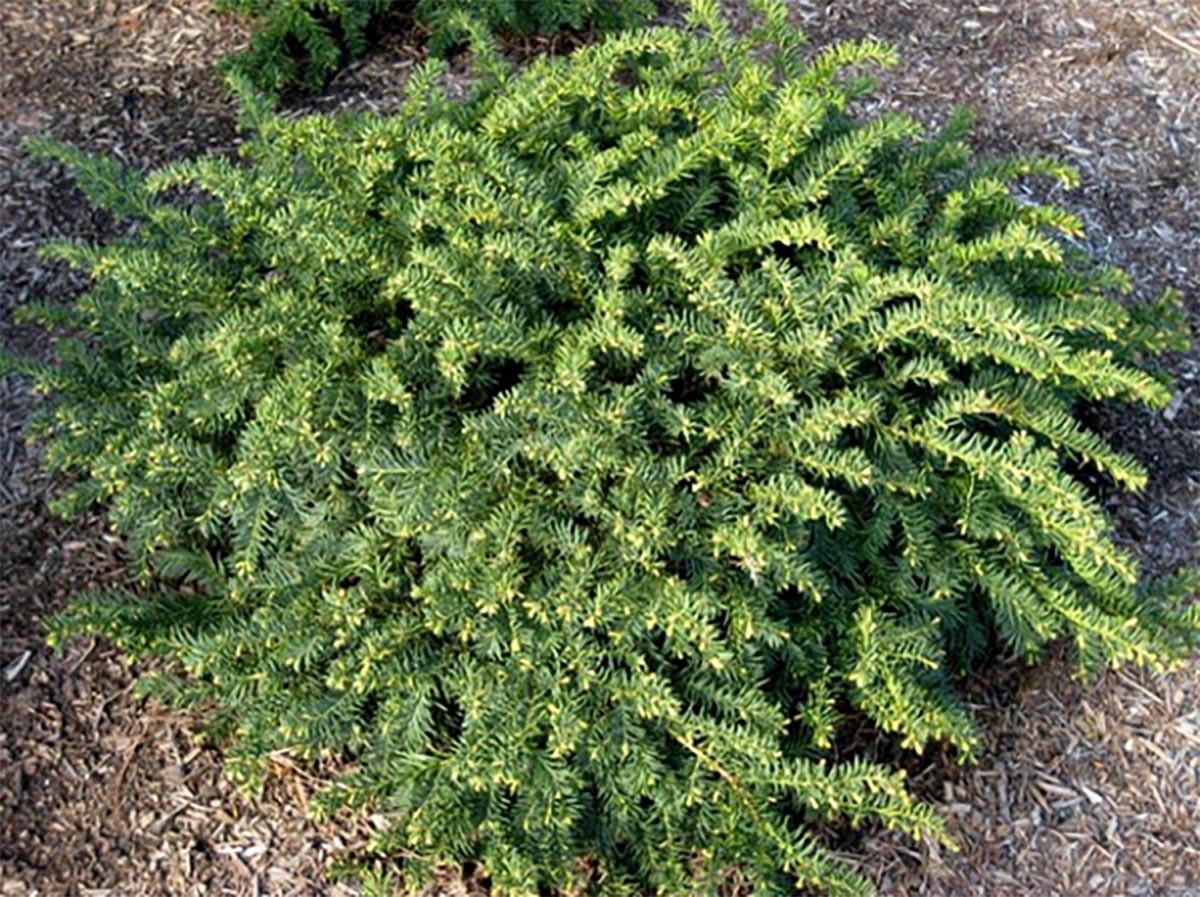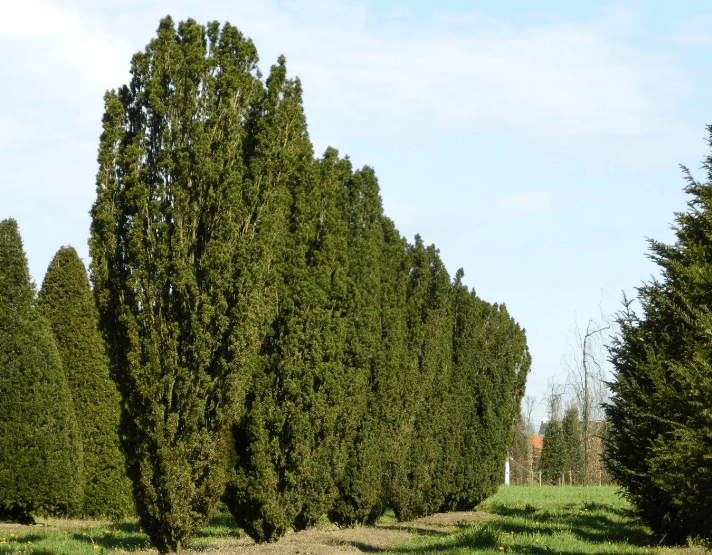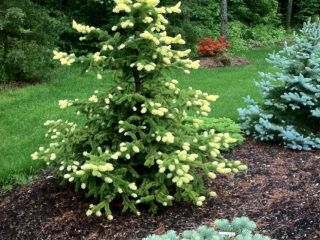Content
- 1 What does yew berry look like?
- 2 Is yew berry edible or not?
- 3 Where does the yew berry grow?
- 4 Varieties of yew berry with photo
- 5 Advantages and disadvantages
- 6 How to grow yew berry
- 7 Caring for berry yew
- 8 Diseases and pests
- 9 Reproduction of yew berry
- 10 Yew in landscape design
- 11 Conclusion
- 12 Reviews of yew berry
Yew berry is an evergreen coniferous, slow-growing tree or shrub, considered a poisonous long-liver of the southern flora. The toxins contained in the plant are used in the production of anticancer drugs. The culture is popular among gardeners because of its unpretentiousness and attractive appearance. It is often used to form green natural hedges in landscape design.
What does yew berry look like?
Poisonous yew is classified as a dioecious plant. The emerging crown is ovoid-cylindrical in shape.

Covered with soft and flat dark green needles 20-35 mm long
Formation of red fruits is observed on female trees. They remain on the branches until the first frost of winter.

A coniferous tree can live for several centuries due to the rapid restoration of damaged parts
The tree grows up to 10 meters, width - up to 4 meters.The trunk and branches contain a lot of phytoncides, which determines its antibacterial properties. Yew berry below 5 meters in height is used in folk medicine.
Is yew berry edible or not?
You need to work with culture carefully. Wood, needles on branches, seeds and buds are considered poisonous. The toxins they contain are used in the manufacture of various antibacterial drugs. But for this they go through several stages of processing.

Female plants can be distinguished from male plants by their bright berries.
You can eat yew berries, taking into account the fact that only the fleshy, juicy, bright pulp is not poisonous - it is sweet and edible. But the hard seeds of the fruit contain many toxins.
Berries appear only on female plants. They are shaped like a glass, which is slightly open at the top. After the onset of cold weather, coniferous crops attract a large number of birds.

The digestive system of birds is adapted to fruits, so seeds do not cause poisoning
Where does the yew berry grow?
The plant's homeland is considered to be the central and southern regions of Europe. Recently, it is rarely found in natural conditions.
In most cases, yew is presented in nature as a shrub. It is found in the spruce forests of the northwestern part of mainland Estonia and on the western part of the islands of Hiiumaa and Saaremaa.
Due to its unpretentiousness, the crop is planted in various regions. It tolerates low temperatures well and is not susceptible to insect attack. It is often used in landscape design.
Varieties of yew berry with photo
Almost all varieties of yew grow slowly. On average, a plant lives about 1.5 thousand years. This is due to its properties, including its branched root system. There are about 800 species in the yew family.
Yew berry Summergold
The name of the variety Summergold translated from English means “golden summer”. This is due to the fact that its needles acquire a yellowish tint. The shrub grows very slowly. The dimensions of this berry yew are compact, no more than 1 m in height and girth.

Summergold has an unusual crown shape that resembles a pillow
Yew berry Fastiagata
The crown of the Fastigiata shrub is characterized by a narrow columnar shape. The color of the needles changes depending on the season. In the cold season it is black-green in color, and with the onset of summer it becomes lighter. This variety grows up to 5 meters with a width of 2 meters. The growth is only 12 cm per year. In landscape design it is used to create an independent composition; small plants are usually planted around it.

Yew Fastiegata does not tolerate sandy soil depleted of nutrients.
Yew berry David
David is considered an ideal variety for arranging a compact ornamental garden. It reaches a height of 2 meters. The shape of the crown resembles a column, the branches are vertical and strong. The needles are yellow; ordinary garden shears are suitable for cutting them. Yew loves light, and over time its color becomes light green. It is recommended to plant the David variety in nutritious, moist soil, mainly limestone.

Often David becomes the central element of a garden composition
Yew berry Elegantissima
Elegantissima is a small plant, reaching only 1 m in height with a diameter of 1.5 m.The needles are light yellow in color with strong shoots. This frost-resistant crop is recommended to be planted in areas protected from the wind. Calcareous and loamy soil is suitable. Severe drought and shade do not have a negative effect.

In Elegantissima yew, as the first frost approaches, the needles begin to “whiten”
Yew berry Repandence
A popular Repandens variety with attractive decorative qualities. This is due to the fact that adult specimens barely reach a height of 0.5 meters. The needles are beautiful, arc-shaped. The shrub should be planted in an area where a lot of light penetrates. The second condition for rapid growth is a sufficient amount of moisture.

Over time, the growth of yew berry Repandens slows down, making it easier to care for
Advantages and disadvantages
The perennial plant is considered shade-loving, but grows well in sunny areas. It is suitable for creating a green natural hedge.

Thanks to its advantages, yew is becoming an increasingly popular plant among gardeners.
Pros:
- frost resistance;
- suitable for decorating the site;
- the plant is not susceptible to most diseases;
- There are no difficulties with cutting if you are careful;
- with proper care it grows for several centuries;
- many varieties of shrubs are no higher than 1 meter.
Minuses:
- almost all parts of the tree are toxic, you need to carefully plant the plant and care for it;
- the berries that appear may attract children, but their seeds are poisonous.
How to grow yew berry
You can grow yew berry only if the plant is planted correctly. Its main enemies are acidic soil, strong winds, drought and high humidity.Yew berry is rarely grown from seeds; it is preferable to purchase a prepared seedling from a nursery.
Planting begins with choosing a location. The plant actively develops only with sufficient lighting of the area, but direct sunlight reduces frost resistance. Therefore, they prefer shady places.
Coniferous shrubs cope well with drought. After several years of development, the root system begins to extract moisture from aquifers that lie at great depths.
Yew berry is used to create a hedge with careful preparation of the soil. The plant requires loose soil rich in humus.

To obtain the correct soil, use peat, sand and turf soil.
The root system of the plant does not tolerate high humidity. Therefore, it is necessary to eliminate the possibility of water stagnation. It is also not recommended to plant in areas where there are high occurrence of aquifers.
Planting work is recommended to be carried out in the spring. The soil should warm up well. Other features of the work being carried out:
- when planting in groups, the distance between individual bushes should be at least half a meter;
- the standard depth of the planting hole is 80 centimeters;
- the formed hole is filled with fertile soil;
- The seedling is lowered so that the root collar is slightly above the soil surface.
After completing the work, the plant must be watered thoroughly. Then mulching is carried out with sawdust and peat.
Caring for berry yew
Regular watering is carried out for two years after planting. If there is a large amount of precipitation, it must be stopped.

10 liters is enough for one tree
Fertilizer is applied every year during the growing season. Suitable drugs are Florovit and Kemira-universal.
The crown is trimmed periodically. They begin to give the desired shape in the first years after planting. The procedure begins with damaged or dry branches, pruning is carried out between March and April.
Diseases and pests
The plant can be attacked by yew false scale insects and flat beetles. Insecticides are used to combat them.

Aktara is an insecticide that can be used against pests on yew berries
Blackening of shoots is caused by fungi. Its primary symptom is the appearance of a film. You can help the plant with fungicides.
Reproduction of yew berry
The plant is propagated by seeds and cuttings. In the first case, it will take a lot of time. The germination period lasts for several years. Seeds can only be collected from yew trees that are at least 25 years old.
Annual and biennial shoots are subject to rooting. They are cut from branches that point upward. Then the cuttings grow into small bushes with a small spread of branches.
Yew in landscape design
One of the reasons for the popularity of yew berry in landscape design is the ability to give the crown an unusual shape. At the same time, its branches are easy to trim.

If pruning is carried out from the first years of growth, the yew gets used to the given shape and retains it as it grows.
When planted tightly, you can create a living fence from yew berries. It will allow you to fence off the area from outsiders.

Due to the poisonous nature of the yew hedge, even animals will not be able to get through it.
Conclusion
Yew berry is increasingly used in landscape design.You need to work with this plant carefully, as toxins are contained in its needles, branches and berries. At the same time, the crown of the tree is quite dense, but can be easily trimmed to give shape. Yew has good frost resistance and practically does not react to attacks by insects and diseases.
Reviews of yew berry








